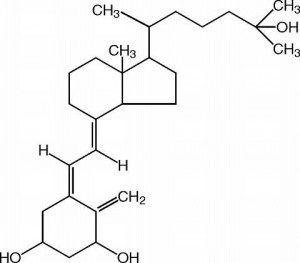 In continuing with the mini-series on vitamin D I’d like to discuss the effect vitamin D (or should that be adequate vitamin D intake) has on muscle tissue. My previous articles on vitamin D discussed its effects on androgen levels, which obviously manifests in a positive effect on muscle balance, but further research into the prohormone suggests it has more direct effects in the tissue. This is because there exists a vitamin D receptor (VDR) that calcitriol (the active form of vitamin D in the body) binds to. This binding activates second messenger systems and influences calcium and phospholipids metabolism. Mice bred without the VDR have major growth issues, muscle impairment and poor physical performance suggesting a direct link between muscle function and adequate vitamin D. Humans who are vitamin D deficient can suffer myopathy, and there is also a suggestion that it can impair balance, leading to more falls. Some cases of deficiency have been reversed via daily supplemental vitamin D, leading to an increase in performance ability over longer periods.
In continuing with the mini-series on vitamin D I’d like to discuss the effect vitamin D (or should that be adequate vitamin D intake) has on muscle tissue. My previous articles on vitamin D discussed its effects on androgen levels, which obviously manifests in a positive effect on muscle balance, but further research into the prohormone suggests it has more direct effects in the tissue. This is because there exists a vitamin D receptor (VDR) that calcitriol (the active form of vitamin D in the body) binds to. This binding activates second messenger systems and influences calcium and phospholipids metabolism. Mice bred without the VDR have major growth issues, muscle impairment and poor physical performance suggesting a direct link between muscle function and adequate vitamin D. Humans who are vitamin D deficient can suffer myopathy, and there is also a suggestion that it can impair balance, leading to more falls. Some cases of deficiency have been reversed via daily supplemental vitamin D, leading to an increase in performance ability over longer periods.
Think back to the previous article on vitamin D, you’ll recall that we derive most of our vitamin D from the sun. With more and more people opting to stay indoors for longer periods of time in order to watch TV, surf the web or play on computer games, this further reinforces the need for us to get outside more, especially when the weather is nicer.
Ironically, a lot of people decide to spend nicer days sat outside in beer gardens, which gives rise to a whole new health risk. But I’ll reserve alcohol discussion for another article.
Source: Ceglia L. Vitamin D and its role in skeletal muscle. Curr Opin Clin Nutr Metab Care. 2009 Nov;12(6):628-33.
